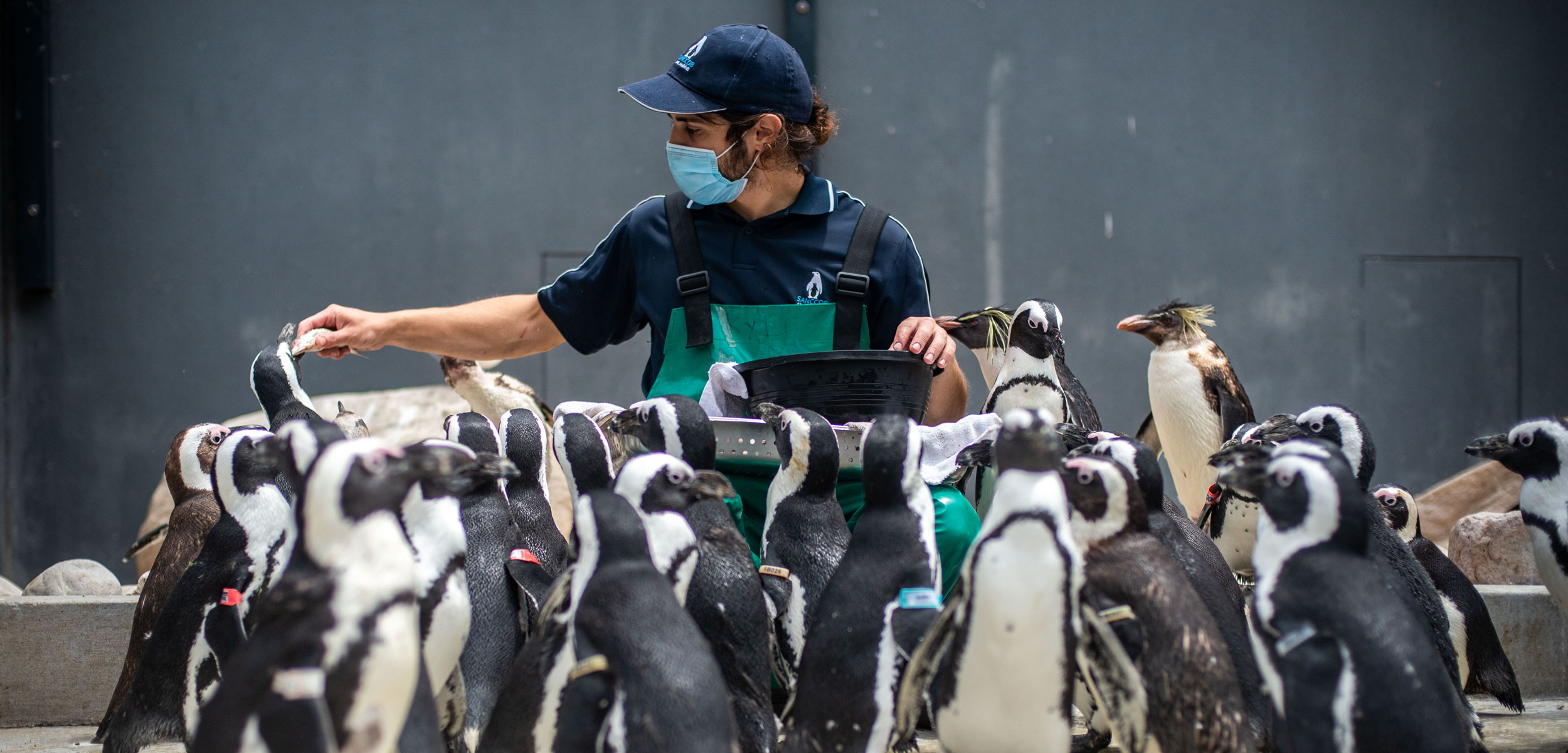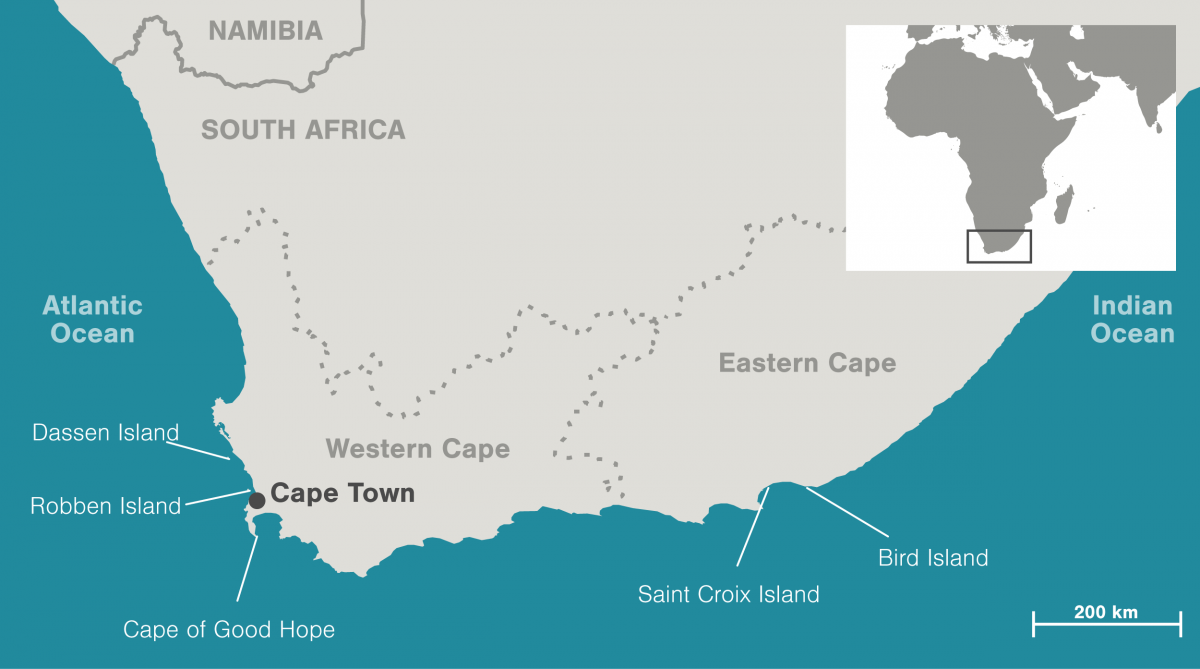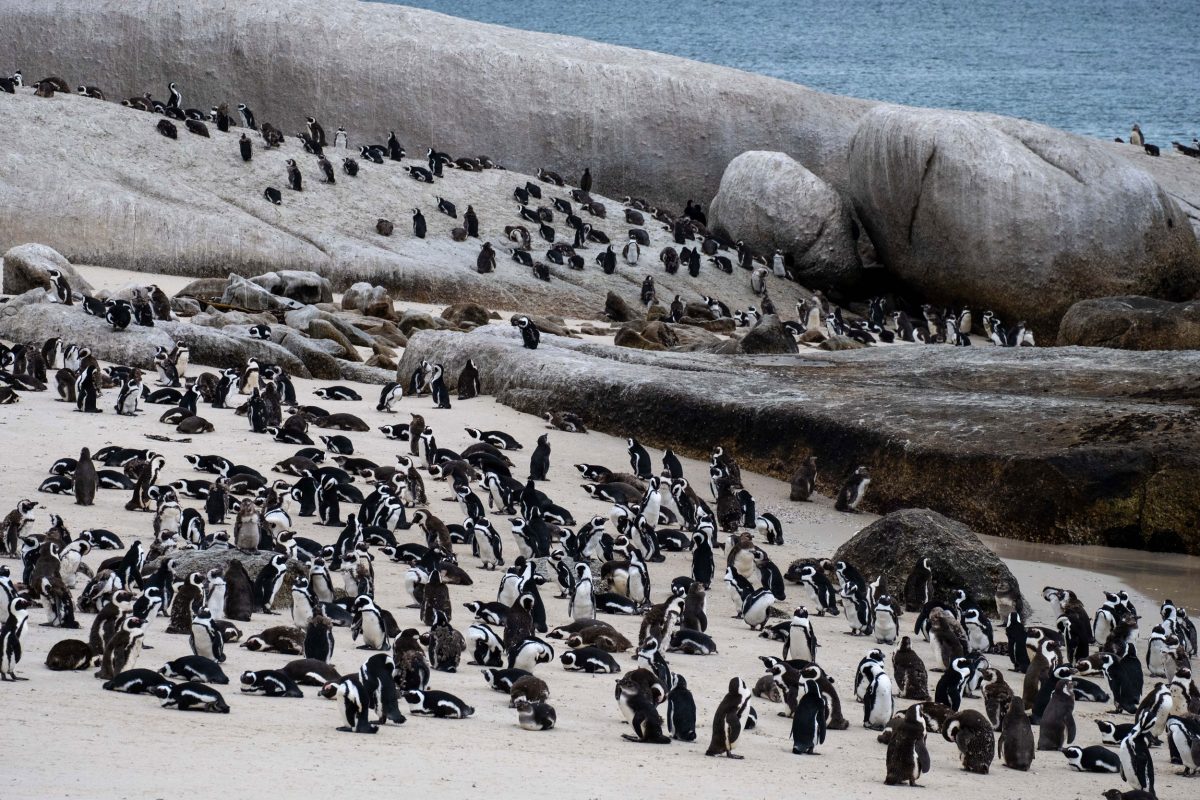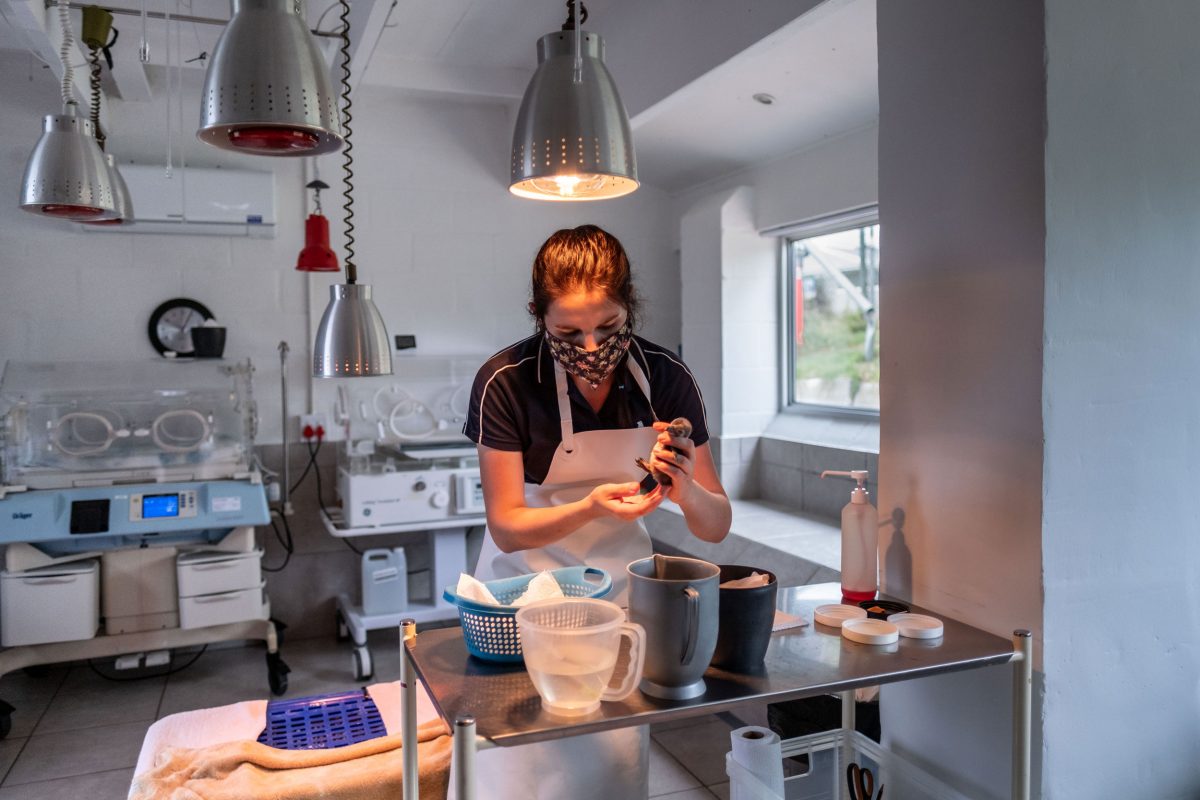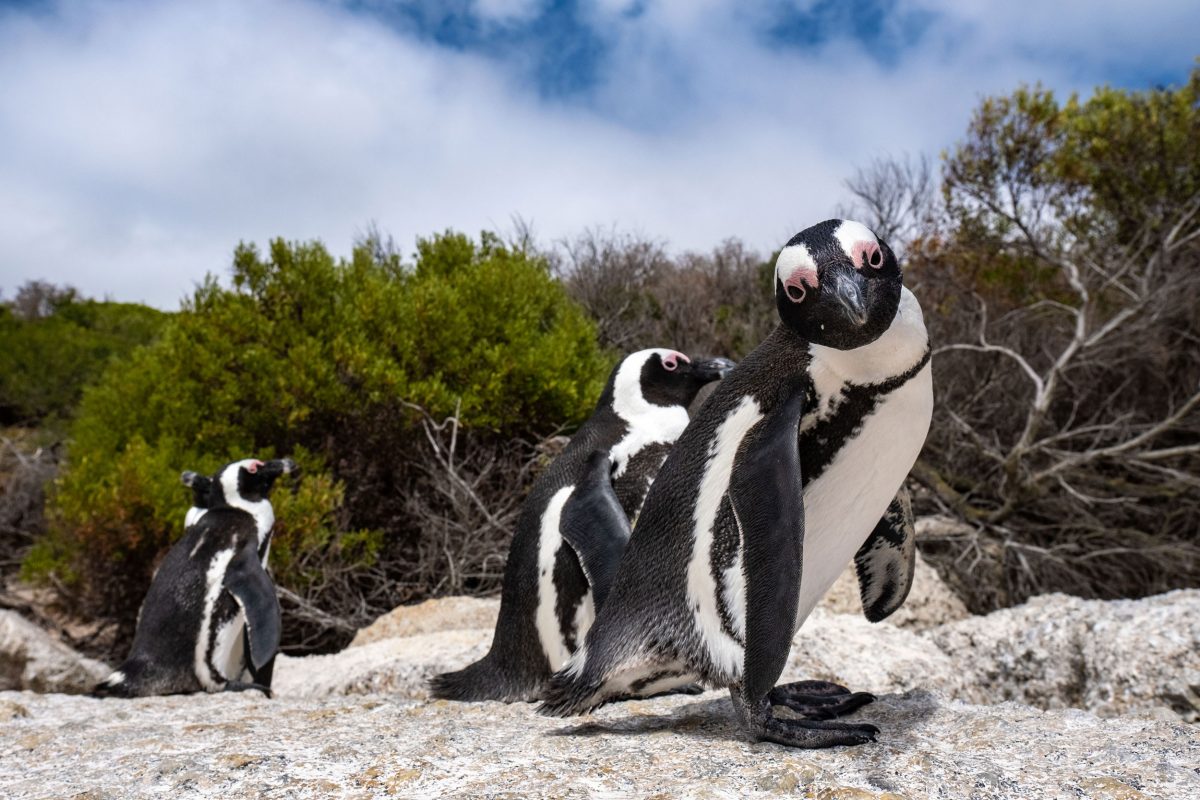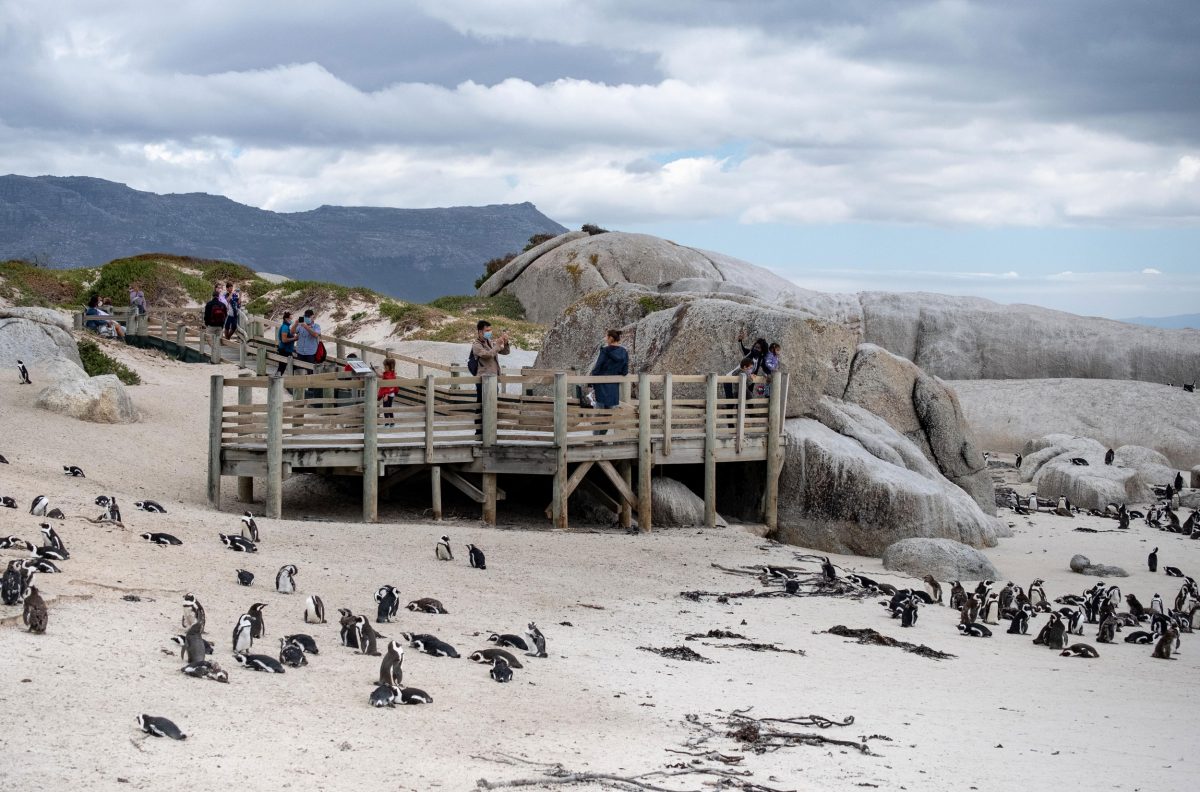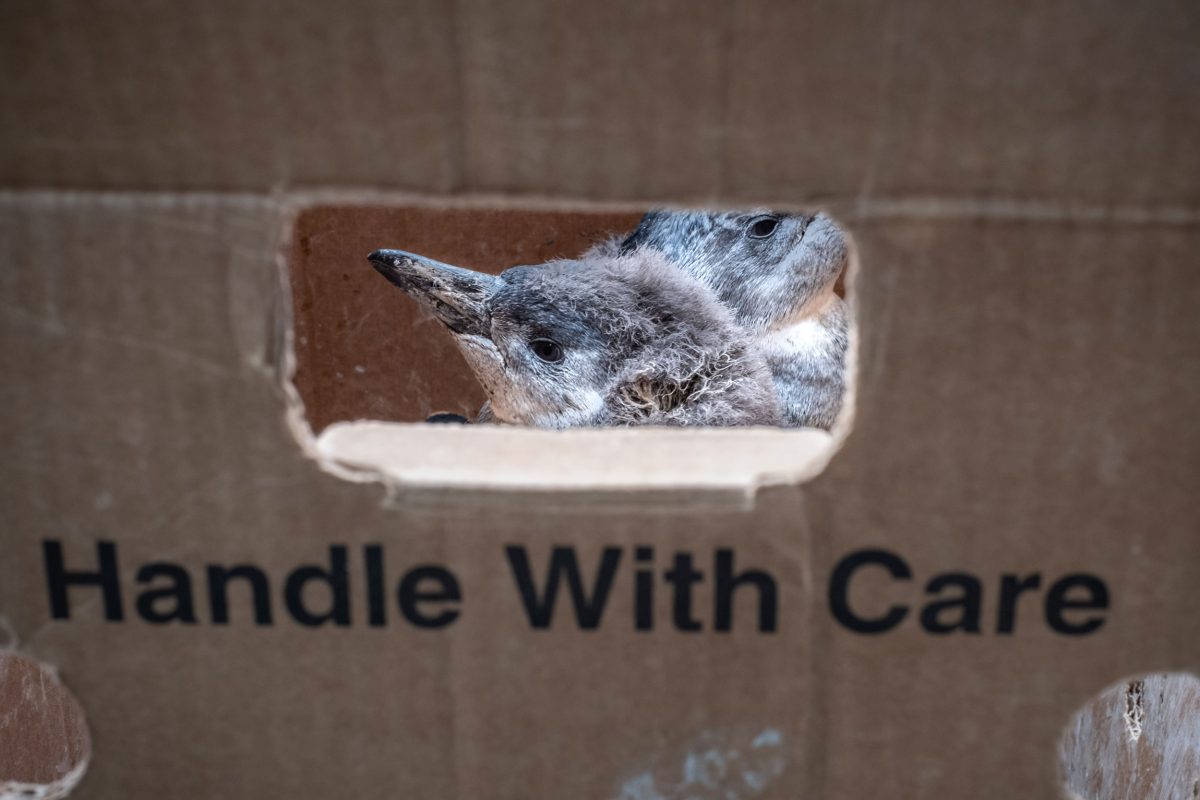As African Penguins Go Hungry, a Debate Rages in South Africa: Who Gets the Fish?
They’ve been robbed of eggs and guano, soaked in oil, and stung by killer bees—now a dispute about numbers could clinch their future.
Article body copy
In a squat white building beside a calm lagoon on the northern edge of Cape Town, South Africa, conservationist Melissa Cadman opens the door of an incubator and pulls out a white egg, flecked with scraps of gray and brown. About twice the size of a chicken’s egg, it fits snugly in her palm. Along its side, faint pencil markings identify it as 1B.
Cadman, wearing a sterile white apron and a face mask decorated with a botanical motif for her daily work here at the Southern African Foundation for the Conservation of Coastal Birds (SANCCOB), carries the egg over to a set of digital scales and scribbles down its current weight: 102 grams. Satisfied, she then switches on a powerful light and rests the egg against it. Using a tattered brown beach towel over her head to block out the ambient light, she bends low and stares intently. The technique, known as candling, allows her to see right through the shell. Inside lies the curled embryo of one of South Africa’s best-loved species: the African penguin.
After a few moments, Cadman emerges from beneath the towel with good news. The embryo looks healthy. In less than two weeks, the chick will be ready to break out, tiny and squealing, into the world. Cadman, who works with an air of calm efficiency, quickly returns the egg to the incubator, where the temperature remains a balmy 36.5 °C, placing it softly on a steel rack.
Egg 1B is one of the lucky ones. It was abandoned by its parents in a penguin colony to the south of Cape Town and would have perished had it not been spotted by a ranger. In the wild, the species is in serious trouble. African penguins may have been South Africa’s most abundant seabird at one time, living in huge colonies scattered along the coast from the Atlantic shoreline of what is now Namibia to the warmer waters of South Africa’s Indian Ocean coastline to the east. They benefited from the rich waters at the confluence of these two oceans, and in particular from the Benguela Current, an upwelling that brings cold, nutrient-rich waters to the surface. But their numbers have plunged from around a million breeding pairs in 1920 to just 13,200 in 2019. Faced with threats on all sides, barely one in three fledglings now survives its first year.
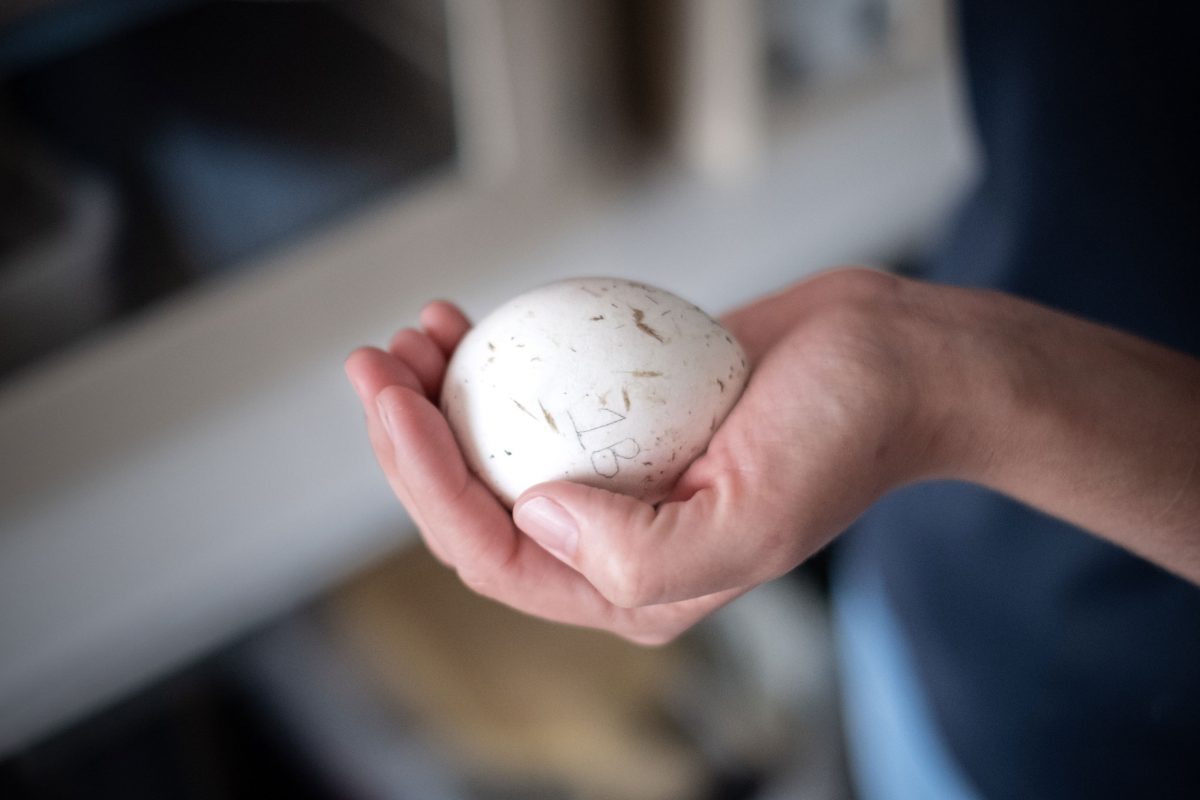
Egg 1B was rescued by a ranger near Cape Town, South Africa, and reared in captivity at the nearby Southern African Foundation for the Conservation of Coastal Birds (SANCCOB).
Seabird scientists say that at the heart of the penguin crisis is one overriding issue—a lack of food. The penguins must compete with the commercial purse-seine fishing fleet for the sardines and anchovies they rely on, and the birds, they say, are losing out. They argue that if the species is to be saved, fishing urgently needs to be banned from within 20 kilometers of the seven largest penguin colonies. For such a ban to be implemented, however, they must convince the South African government that it would significantly help the species, and with fisheries scientists questioning whether fishing is truly to blame for the penguin crisis, this has been no easy task. For over a decade, ever since an experiment was launched in a bid to settle the matter, a bitter debate that has highlighted some of the most fundamental questions of sustainable fisheries management has been raging between the two sides. Now, at long last, with Africa’s only penguin species teetering toward extinction, it may finally be nearing a conclusion.
The threats to African penguins have evolved over time, yet a consistent thread runs throughout: their interactions with humans have been disastrous. The first written reference to the birds comes from an account of Vasco da Gama’s 1497 voyage to India. The Portuguese explorer and his crew paused at the Cape of Good Hope as they rounded the African continent and slaughtered as many penguins as they could get their hands on before continuing on their way.
Being flightless and slow-moving on land, penguins are uniquely easy to catch, as early accounts point out: “Large flocks of them are driven into a corner and clubbed to death, since they cannot run well and fly even worse,” wrote Otto Mentzel, a Prussian traveler living on the Cape in the mid-18th century.
Early mariners and settlers routinely carved the penguins up and salted them for food, plucked them for their downy feathers, and rendered them down for their fat. But the most destructive practice was the harvesting of their eggs, which occurred on a massive scale well into the 20th century. Official records show that between 1900 and 1930, when the practice was at its peak, some 13 million eggs were taken for human consumption from Dassen Island alone. Egg collectors would destroy eggs that were too well developed to be eaten, in order to encourage birds to lay new ones. It’s said that as recently as the 1960s, penguin eggs, which have a fishy flavor, were a regular feature on the menu in the South African parliament.
Penguins also suffered historically from a second major scourge—guano stripping. Harvesters would scramble onto the birds’ breeding islands and scrape away their droppings with shovels. Used as a fertilizer for crops, guano was such a valuable commodity that in the late 1800s it sparked an international conflict between Spain and newly independent Peru that ended up drawing in several other South American nations. Around the same time, South Africa’s guano strippers set about removing vast quantities of the stuff. For the penguins, the guano, which could be several meters thick, had provided a soft but stable substance they could burrow into during nesting season. Without guano, they were forced to lay eggs in the open, unprotected against heat and storms, and vulnerable to predation by gulls.
Eventually, in the mid-20th century, the South African government outlawed the collection of both eggs and guano from penguin colonies. But no sooner had these threats eased than overfishing for sardines off the country’s Western Cape province triggered a dramatic crash in the supply of the penguins’ most nutritious food.
Other factors have undermined penguins, as well. Oil spills have taken a heavy toll, with a single incident in the year 2000 affecting nearly 40,000 penguins, more than the total remaining population today. Diseases like bird flu and avian malaria; natural predation by gulls, seals, and caracals; and road mortality in mainland colonies all factor in. And rising temperatures make it harder for penguin parents to remain on their nests without overheating. Freak events have also chipped away at the dwindling numbers—in September 2021, more than 60 penguins were killed by a swarm of bees. Studies estimate that, together, these factors could see the species go functionally extinct by 2035, meaning its numbers would have sunk so low that it could no longer play an active role in the ecosystem.
At SANCCOB, Cadman and her colleagues know that the hatchery program alone can’t stop the penguin’s rapid decline, but with so few birds remaining in the wild, every single chick they raise is seen as a small victory. As Cadman puts it, “Every egg is golden.”
While she attends to egg 1B, her colleague, clinical veterinarian David Roberts, checks on a stream of sick and injured penguins. Roberts, lanky with a mass of wavy brown hair tied back in a tight ponytail, started out working with lions and other big cats before switching to seabirds a few years ago. His current patient has an infected foot. The bird struggles in an assistant’s grip as the veterinarian wraps a crimson bandage around the swollen appendage. Next, Roberts places a stethoscope against the penguin’s chest and listens for a moment to monitor the heart and lungs. Everything seems in order. Finally, the assistant places the bird in a crate on top of a scale and notes its weight before returning it to its pen and bringing out another.

Xolani Lawo and Trudi Malan of the African Penguin and Seabird Sanctuary in Gansbaai, South Africa, treat a sick penguin rescued from a colony on Dyer Island.
Alongside a population of resident penguins unfit for release into the wild, SANCCOB is usually home to dozens, at times even hundreds, of inpatients, contending with all manner of ailments from seal bites to parasitic infections. But Roberts says that most birds brought into SANCCOB are suffering directly or indirectly from a lack of food. Chest infections tend to strike undernourished, immunocompromised birds. Parasites, too, generally afflict the weak and underfed. He sees regular seasonal influxes of chicks abandoned by parents unable to feed them. And periodically, he has to nurse back to health penguins that failed to complete their annual molt: when replacing their worn-out feathers with new ones, penguins must stay on dry land to keep warm, but if they haven’t been able to sufficiently fatten up beforehand, they can be forced back into the frigid sea before their feathers have grown in. Then there are the anemic birds, which urgently require shots of iron and vitamin B once they reach the sanctuary. Much of SANCCOB’s work involves fattening up patients with nutritional supplements and regular servings of sardines.
“We see a lot of chicks that have fledged and left colonies, and naturally they would move up the west coast to where the high historical fish numbers were,” Roberts explains. “But they get there and there are no fish, so often we find these really weak, emaciated fledglings.”
At seabird sanctuaries up and down the coast, staff are encountering similar issues. At the Seabird and Penguin Rehabilitation Centre in the fishing town of Mossel Bay, staff have been finding smaller and smaller juveniles washing up on beaches, likely because their parents stopped being able to feed them. And at the African Penguin and Seabird Sanctuary (APSS) in the town of Gansbaai, a two-hour drive southeast of Cape Town, caring for underweight chicks takes up a large part of the daily routine, even though nearby fish stocks have fared somewhat better than in other areas.
The penguins have been “showing us that there’s something wrong in the [eco]system,” says Trudi Malan, conservation manager for APSS. “They’ve been sounding alarm bells for quite a number of years.” Malan points out that the fate of the penguin has a broader significance for other marine life: being near the top of the food chain, penguins are considered an indicator species, meaning that their status tends to reflect the health of the ecosystem in which they live.
“We’re doing great in here,” says another frustrated sanctuary worker, who asked not to be named. “But if nothing changes out there [in the ocean], then it makes you ask, ‘What’s the point?’ We’re just spending money.”
Seabird scientists point out that the populations of penguins and small pelagic fish have appeared to rise and fall in tandem in recent decades. While the penguin population has decreased, on average, by nearly five percent per year for the past 30 years, there was one brief period around the turn of the century when the decline not only stopped, but actually reversed. This coincided with an eightfold increase in sardine numbers between 1996 and 2002. (Sardines and anchovies are known to have occasional population booms, or outbreaks, when breeding and feeding conditions align.) When the sardine population dropped again, the penguin numbers followed. Similarly, when, for reasons not fully understood, the bulk of the sardine biomass shifted from the waters around Cape Town toward the southeast, the western penguin colonies crashed, while the southern and eastern ones held up considerably better. In 2017, a team of researchers led by Richard Sherley at the University of Exeter in England put satellite trackers on 54 juvenile penguins and uncovered what’s known as an ecological trap: the penguins tended to follow environmental cues to sites that were historically rich in sardines and anchovies, only to find those stocks largely gone. The researchers concluded that this trap could be reducing breeding numbers by around 50 percent.
Seabird scientists began calling for fishing closures back in 2006. Yet government officials responsible for managing the small pelagic fishery demurred. If they were to consider restricting the sardine fleet from fishing in some of the region’s most productive waters, they would require further proof that it would actually help the penguins. The small pelagic fishery, which primarily targets sardines, anchovies, and round herring—some for human consumption and some for fish meal used in agriculture and aquaculture—is South Africa’s largest, by total mass caught, and provides jobs for thousands in a country where approximately one in three people is unemployed.
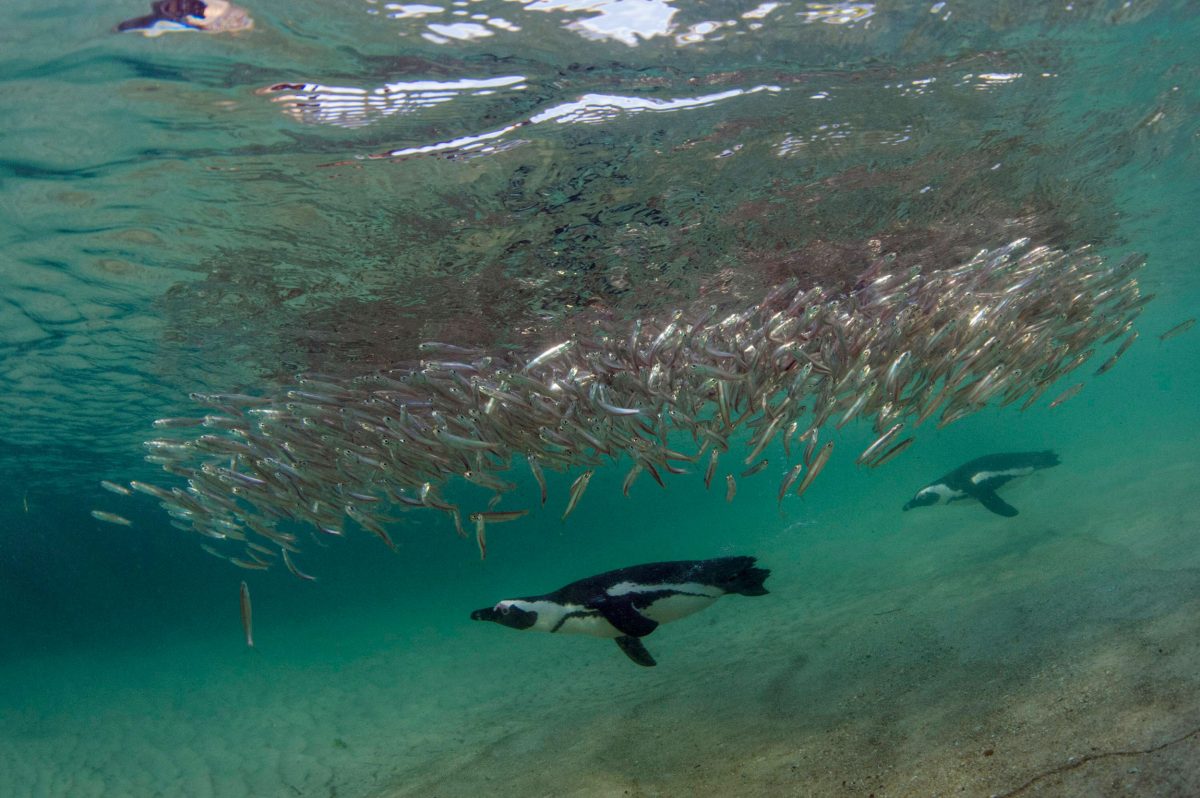
African penguins feed primarily on sardines and anchovies, which are also targeted by the fishing industry.
“We can’t take decisions lightly,” says Janet Coetzee, the vice chair of the small pelagic scientific working group, the primary advisory body within South Africa’s fisheries department responsible for advising the minister on the management of the fishery. “We have to be so sure of ourselves before we make recommendations that could have far-reaching consequences for not only the fishing industry, but for many fishing communities and coastal towns that rely on these fisheries.”
In 2008, South Africa’s fisheries management branch, then part of the Department of Environmental Affairs and Tourism, launched a rare experiment that aimed to show definitively whether fishing around penguin colonies had a significant impact on penguin population numbers. Two pairs of islands—Dassen and Robben Islands, which sit around 50 kilometers apart in Western Cape, and Saint Croix and Bird Islands, located a similar distance from each other in Algoa Bay in the province of Eastern Cape—which host the majority of the remaining penguin population, were selected for alternating fishing closures. For a cycle of three years, the waters surrounding one island in each pair would be closed to fishing while the area around its neighboring island was left open. At the same time, scientists would monitor a range of indicators, such as chick survival rate, chick body condition, and adult foraging range.
The experiment, designed with input from all the various interested groups, ran until 2019. But far from establishing a consensus, its findings have become the focus of a bitter disagreement between seabird scientists and conservationists on the one hand and fisheries management scientists on the other. Thirteen years since data began to flow in, a war of words is still being fought in academic journals, the press, direct entreaties to government ministers, and in particular, the small pelagic scientific working group in the fisheries management branch, now housed in the Department of Forestry, Fisheries, and the Environment, with the two sides quibbling over everything from the mathematical interpretation of the data to the methodology of the experiment itself.
Papers published by the seabird science and conservation faction—which includes academics from the Universities of Cape Town and Exeter, along with groups like the World Wide Fund for Nature and BirdLife International—point out that, despite the limitations inherent in trying to conduct a controlled experiment in a complex, changeable ecosystem, scientifically significant signals did emerge at certain islands. For example, at Robben Island, chick condition, as calculated with head length and body mass, was found to improve by some 48 percent during years with no fishing, and chick survival rates improved by 10 percent. At Dassen Island, too, chick survival improved significantly during the years of fishing closures. And population projection models for both islands, calculated using a mathematical technique known as Bayesian inference, showed that without fishing pressure, the penguin population in 2035 could be 20 percent larger than it would be if fishing were to continue—the fishing closures would not be enough to single-handedly arrest the decline, but would be an essential part of the broader fight to save the species.
“We’re not saying don’t fish. We’re saying, ‘Can you just fish a bit further away?’” says Lauren Waller, a longtime penguin conservationist and an advocate for the establishment of no-take zones around the colonies.
Like other seabird scientists and conservationists, Waller holds observer status in the small pelagic scientific working group, allowing her to participate in debates but little more—all of the group’s voting members are affiliated with the government’s fisheries management branch. During the 13 years of argument, she has watched the penguin population more than halve, and feels an increasing sense of frustration with the process. “I think this year, it’s crunch time, now. It becomes a point where the birds are going to decline to such a level that they won’t be able to recover,” she says. “The science is there, the evidence is there. What more do we need to do?”
Meanwhile, based on their own analysis of the data, government fisheries officials say the picture is far from clear. At Bird Island, no clear pattern emerged. And though chick survival may have increased on Dassen Island during years of fishing closures, the analysis showed that, counterintuitively, chick growth rates were reduced and adult foraging distance actually increased. This led some to speculate that the purse-seine fishing fleet could actually help the penguins by breaking up shoals of fish and making them easier to hunt. Others put the blame on increased seal populations and the legacy of the guano removal. Even where the closures do appear to have a clear positive impact, the fisheries management officials argue that it is not enough to halt, let alone reverse, the rapid overall decline in penguin numbers.
“If you take it to the extreme and say, ‘Let’s stop fishing on all small pelagic fish, on all species that penguins prey on, tomorrow, is that going to help?’ And from our perspective, and our knowledge of how well we are managing the fishery, we would say no,” says Coetzee.
The debate, which has at times become so heated that outside mediators have had to be brought in to try and keep the peace, has brought into focus questions of sustainable fisheries management that are pertinent to myriad other contexts around the world. How can we obtain clear results from experiments that take place in complex, dynamic ecosystems? And in the absence of comprehensive, detailed data, to what extent should decision-makers follow the precautionary approach, prioritizing marine protections until doubt is eliminated? How effective can small-scale marine protected areas be for migratory fish like sardines and mobile predators like penguins? And to what extent can different mathematical interpretations shape the outcome of experiments?
For the South African fishing industry, there is much at stake. After the crash in sardine stocks in the 1960s, it was decades before the population began to recover. And despite a brief boom in the late 1990s, their numbers remain extremely low today: many of the country’s canneries now import frozen sardines from Morocco and elsewhere in order to continue operating. The small pelagic fishery is an “opportunistic” one, explains Mike Copeland, who chairs the South African Pelagic Fishing Industry Association (SAPFIA), meaning that the fish can only be caught during certain periods and in certain locations. “When fish is available, you need to be there and you need to catch it,” he says. Extrapolating from calculations based on Robben and Dassen Islands, SAPFIA estimates that the cost to the economy as a whole of permanent fishing closures around the six largest penguin colonies could be as high as 450 million rand (roughly US $30-million) per year.
In response, seabird scientists point out that penguin-related tourism revenue should also be considered: the colony at Boulders Beach, for example, located in a sandy cove on the southern edge of Cape Town, is one of the city’s main tourism attractions. Before the pandemic, hundreds of thousands of visitors would pass through the turnstiles each year to watch the birds from a series of wooden walkways and platforms. A study commissioned by the City of Cape Town estimates the tourism revenue associated with the colony to be as high as $19.5-million per year. Tourists benefited local businesses, and the revenue generated by park entry fees helped the national parks service protect dozens of other less prominent species in parks around the country.
Ultimately, however, with the findings of the island closure experiment still contested, both sides know the decision must be a political one, a trade-off between safeguarding one of the country’s best-loved species and protecting an important industry that provides a livelihood for thousands. By the beginning of 2022, that decision finally appeared to be drawing closer, with Barbara Creecy, South Africa’s minister of forestry, fisheries, and the environment, expected to make a ruling imminently.
In an effort to finally reach a decision on the fishing-closure issue, Creecy formed a new task team in the second half of 2021 that brought representatives from both sides of the debate together for a series of meetings, giving them equal opportunity to voice concerns. Now, they anxiously await her decision—though some feel that a form of compromise is likely. As one fisheries consultant puts it, “You’re probably going to end up with a final decision that everybody’s equally unhappy about.”
In the meantime, the increasingly desperate work of trying to bolster the penguin population continues. Half a dozen sanctuaries now take in and rehabilitate hundreds of sick or injured birds each year, and conservation groups have been installing increasingly sophisticated nest boxes to help the birds breed and compensate for the loss of the guano. In June 2021, BirdLife South Africa released 30 juvenile penguins in a nature reserve to the east of Cape Town in an ambitious effort to start a whole new colony. The group has even installed decoy penguins in hopes of attracting more new residents. So iconic are the penguins that extraordinary measures have been considered; an idea was even mooted to set up sprinklers at Boulders Beach to spray cooling mist over the penguins to alleviate the effects of climate change. And all the while, Cadman’s hatchery at SANCCOB continues to raise new chicks from eggs recovered from colonies, though she sometimes wonders how they will fare when released into an ocean ecosystem that may simply no longer be able to support them.
A few weeks after egg 1B arrives at SANCCOB, the first cracks appear in its shell, and two days later a tiny ball of fluff, barely the size of a tennis ball, emerges into the obsessively controlled air of the chick rearing unit. Weighing no more than a deck of cards, it takes several hours to dry off, and soon receives its first meal, a solution of probiotics administered through a tube by Cadman. It’s also given a new name—African penguin 464.
For its first few days, 464 lives in an incubator inside a small plastic pot, which it shares with a diminutive crocheted teddy bear placed there by Cadman to make it feel more comfortable. The chick is healthy and responds well to food. At first, it feeds on warm sardine smoothie, before progressing to sardine fillets and then eventually to whole sardines, which it gulps down with a flick of its head. During the first few weeks, it rapidly puts on weight; in one case its body weight increases by 17 percent in a single night.
By two months old, 464 has developed the handsome watertight plumage of adolescence. Penguins in this phase are known as blues, for the metallic bluish sheen of their feathers. Now weighing over two kilograms, 464 has developed an affinity for swimming, a rarity among African penguins reared in sanctuaries. In fact, 464 takes to the water so enthusiastically that at times staff have to chase it out of the swimming pool so others can have a turn.
On the 94th day after egg 1B hatched, Roberts, the veterinarian, clears 464 for release, and two days later the bird is placed in a cardboard box labeled Handle With Care and loaded onto a truck. After an hour-long trip through the city of Cape Town, past the looming hulk of Table Mountain, 464 arrives at Boulders Beach, where a ranger opens the box, giving the young penguin its first look at the ocean. It stumbles out, all stubby legs and flapping wings, and waddles awkwardly down the white sand toward the lapping turquoise waves and a future clouded with uncertainty.
Penguins of 464’s age tend to spend several years foraging at sea before joining a colony, so Cadman and her colleagues do not expect any sightings in the near future. But surviving that long will be no easy feat. To do so, 464 will need to avoid attack by sharks and seals, steer clear of oil spills and entanglement in drifting plastics, and overcome the infections and parasites that will likely come its way. Most critically of all, the young penguin will need to find and consume enough sardines and anchovies to stay strong and healthy and sustain its body fat in these frigid waters. If 464 can do all of this, then one day its microchip may ping off a transponder reader at one of the colonies, and Cadman will know that her hard work in raising it from an egg has paid off. Until then, all she can do is wait.

